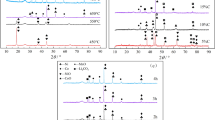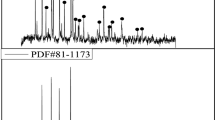Abstract
In the production of lithium-ion batteries (LIBs) and recycling of spent LIBs, a large amount of low-concentration lithium-containing wastewater (LCW) is generated. The recovery of Li from this medium has attracted significant global attention from both the environmental and economic perspectives. To achieve effective Li recycling, the features of impurity removal and the interactions among different ions must be understood. However, it is generally difficult to ensure highly efficient removal of impurity ions while retaining Li in the solution for further recovery. In this study, the removal of typical impurity ions from LCW and the interactions between these species were systematically investigated from the thermodynamic and kinetics aspects. It was found that the main impurities (e.g., Fe3+, Al3+, Ca2+, and Mg2+) could be efficiently removed with high Li recovery by controlling the ionic strength of the solution. The mechanisms of Fe3+, Al3+, Ca2+, and Mg2+ removal were investigated to identify the controlling steps and reaction kinetics. It was found that the precipitates are formed by a zero-order reaction, and the activation energies tend to be low with a sequence of fast chemical reactions that reach equilibrium very quickly. Moreover, this study focused on Li loss during removal of the impurities, and the corresponding removal rates of Fe3+, Al3+, Ca2+, and Mg2+ were found to be 99.8%, 99.5%, 99%, and 99.7%, respectively. Consequently, high-purity Li3PO4 was obtained via one-step precipitation. Thus, this research demonstrates a potential route for the effective recovery of Li from low-concentration LCW and for the appropriate treatment of acidic LCW.

Similar content being viewed by others
References
Chi S S, Liu Y, Song W L, Fan L Z, Zhang Q. Prestoring lithium into stable 3D nickel foam host as dendrite-free lithium metal anode. Advanced Functional Materials, 2017, 27(24): 1700348
Etacheri V, Marom R, Elazari R, Salitra G, Aurbach D. Challenges in the development of advanced Li-ion batteries: A review. Energy & Environmental Science, 2011, 4(9): 3243–3262
Lv W G, Wang Z H, Cao H B, Sun Y, Zhang Y, Sun Z. A critical review and analysis on the recycling of spent lithium-ion batteries. ACS Sustainable Chemistry & Engineering, 2018, 6(2): 1504–1521
Zeng X L, Li J H, Shen B Y. Novel approach to recover cobalt and lithium from spent lithium-ion battery using oxalic acid. Journal of Hazardous Materials, 2015, 295: 112–118
Li L, Qu W J, Zhang X X, Lu J, Chen R J, Wu F, Amine K. Succinic acid-based leaching system: A sustainable process for recovery of valuable metals from spent Li-ion batteries. Journal of Power Sources, 2015, 282: 544–551
Zheng X H, Gao W F, Zhang X H, He M M, Lin X, Cao H B, Zhang Y, Sun Z. Spent lithium-ion battery recycling-Reductive ammonia leaching of metals from cathode scrap by sodium sulphite. Waste Management (New York, N.Y.), 2017, 60: 680–688
Swain B. Recovery and recycling of lithium: A review. Separation and Purification Technology, 2017, 172: 388–403
Yu L H, Miao J S, Jin Y, Lin Y S. A comparative study on polypropylene separators coated with different inorganic materials for lithium-ion batteries. Frontiers of Chemical Science and Engineering, 2017, 11(3): 346–352
Wang S Q, Guo Y F, Zhang N, Bu L Z, Deng T L, Zheng M P. Caloric evaporation of the brine in Zangnan Salt Lake. Frontiers of Chemical Science and Engineering, 2011, 5(3): 343–348
Vieceli N, Nogueira C A, Pereira M F C, Durão F O, Guimarães C, Margarido F. Recovery of lithium carbonate by acid digestion and hydrometallurgical processing from mechanically activated lepidolite. Hydrometallurgy, 2018, 175: 1–10
Wang H Y, Zhong Y, Du B Q, Zhao Y J, Wang M. Recovery of both magnesium and lithium from high Mg/Li ratio brines using a novel process. Hydrometallurgy, 2018, 175: 102–108
Schneidera A, Schmidta H, Mevenb M, Brendlerc E, Kirchnerd J, Martine G, Bertaue M, Voigt W. Lithium extraction from the mineral zinnwaldite: Part I: Effect of thermal treatment on properties and structure of zinnwaldite. Minerals Engineering, 2017, 111: 55–67
Jandová J P, Dvořák P, Vu H N. Processing of zinnwaldite waste to obtain Li2CO3. Hydrometallurgy, 2010, 103(1–4): 12–18
Yang S X, Zhang F, Ding H P, He P, Zhou H S. Lithium metal extraction from seawater. Joule, 2018, 2(9): 1648–1651
Kesler S E, Gruber P W, Medina P A, Keoleian G A, Everson M P, Wallington T J. Global lithium resources: Relative importance of pegmatite, brine and other deposits. Ore Geology Reviews, 2012, 48(5): 55–69
Luo X B, Guo B, Luo J M, Deng F, Zhang S Y, Luo S L, Crittenden J. Recovery of lithium from wastewater using development of Li ion-imprinted polymers. ACS Sustainable Chemistry & Engineering, 2015, 3(3): 460–467
Sun Z, Cao H B, Venkatesan P, Jin W, Xiao Y P, Sietsma J, Yang Y X. Electrochemistry during efficient copper recovery from complex electronic waste using ammonia based solutions. Frontiers of Chemical Science and Engineering, 2017, 11(3): 308–316
Xu X, Chen Y M, Wang P Y, Gasem K, Wang K Y, He T, Adidharma H, Fan M H. Extraction of lithium with functionalized lithium ion sieves. Progress in Materials Science, 2016, 84: 276–313
Zandevakili S, Ranjbar M, Ehteshamzadeh M. Recovery of lithium from Urmia Lake by a nanostructure MnO2 ion sieve. Hydrometallurgy, 2014, 149: 148–152
Yan Q X, Li X H, Wang Z X, Wu X F, Wang J X, Guo H J, Hu Q Y, Peng W J. Extraction of lithium from lepidolite by sulfation roasting and water leaching. International Journal of Mineral Processing, 2012, 110–111: 1–5
Kong W B, Miao Q, Qing P Y, Baeyens J, Tan T W. Environmental and economic assessment of vegetable oil production using membrane separation and vapor recompression. Frontiers of Chemical Science and Engineering, 2017, 11(2): 166–176
Somrani A, Hamzaoui A H, Pontie M. Study on lithium separation from salt lake brines by nanofiltration (NF) and low pressure reverse osmosis (LPRO). Desalination, 2013, 317: 184–192
Fridman-Bishop N, Tankus K A, Freger V. Permeation mechanism and interplay between ions in nanofiltration. Journal of Membrane Science, 2018, 548: 449–458
Chen Q B, Ji Z Y, Liu J, Zhao Y Y, Wang S Z, Yuan J S. Development of recovering lithium from brines by selective-electrodialysis: Effect of coexisting cations on the migration of lithium. Journal of Membrane Science, 2018, 548: 408–420
Ji Z Y, Chen Q B, Yuan J S, Liu J, Zhao Y Y, Feng W X. Preliminary study on recovering lithium from high Mg2+/Li+ ratio brines by electrodialysis. Separation and Purification Technology, 2017, 172: 168–177
Kim S, Kim J, Kim S, Lee J, Yoon J. Electrochemical lithium recovery and organic pollutant removal from industrial wastewater of a battery recycling plant. Environmental Science. Water Research & Technology, 2017, 4(2): 175–182
Ooi K, Sonoda A, Makita Y, Chitrakar R, Tasaki-Handa Y, Nakazato T. Recovery of lithium from salt-brine eluates by direct crystallization as lithium sulfate. Hydrometallurgy, 2017, 174: 123–130
Hong H J, Park I S, Ryu T, Ryu J, Kim B G, Chung K S. Granulation of Li1.33Mn1.67O4 (LMO) through the use of cross-linked chitosan for the effective recovery of Li+ from seawater. Chemical Engineering Journal, 2013, 234: 16–22
Zhu G R, Wang P, Qi P F, Gao C J. Adsorption and desorption properties of Li+ on PVC-H1.6Mn1.6O4 lithium ion-sieve membrane. Chemical Engineering Journal, 2014, 235(1): 340–348
Wang S L, Zheng S L, Wang Z M, Cui W W, Zhang H L, Yang L R, Zhang Y, Li P. Superior lithium adsorption and required magnetic separation behavior of iron-doped lithium ion-sieves. Chemical Engineering Journal, 2018, 332: 160–168
Zhang L Y, Zhou D L, Yao Q Q, Zhou J B. Preparation of H2TiO3-lithium adsorbent by the sol-gel process and its adsorption performance. Applied Surface Science, 2016, 368: 82–87
Paranthaman M P, Li L, Luo J Q, Hoke T, Ucar H, Moyer B A, Harrison S. Recovery of lithium from geothermal brine with lithium-aluminum layered double hydroxide chloride sorbents. Environmental Science & Technology, 2017, 51(22): 13481–13486
Mishra B, Costu S. Materials sustainability for environment: Redmud treatment. Frontiers of Chemical Science and Engineering, 2017, 11(3): 483–496
Luo X B, Zhang K, Luo J M, Luo S L, Crittenden J. Capturing lithium from wastewater using a fixed bed packed with 3-D MnO2 ion cages. Environmental Science & Technology, 2016, 50(23): 13002–13012
Pranolo Y, Zhu Z W, Cheng C Y. Separation of lithium from sodium in chloride solutions using SSX systems with LIX 54 and Cyanex 923. Hydrometallurgy, 2015, 154: 33–39
Li X H, Zhang C J, Zhang S N, Li J X, He B Q, Cui Z Y. Preparation and characterization of positively charged polyamide composite nanofiltration hollow fiber membrane for lithium and magnesium separation. Desalination, 2015, 369: 26–36
Nie X Y, Sun S Y, Sun Z, Song X F, Yu J G. Ion-fractionation of lithium ions from magnesium ions by electrodialysis using monovalent selective ion-exchange membranes. Desalination, 2017, 403: 128–135
Gao W F, Zhang X H, Zheng X H, Lin X, Cao H B, Zhang Y, Sun Z. Lithium carbonate recovery from cathode scrap of spent lithium-ion battery: A closed-loop process. Environmental Science & Technology, 2017, 51(3): 1662–1669
Yang Y X, Zheng X H, Cao H B, Zhao C L, Lin X, Ning P G, Zhang Y, Jin W, Sun Z. A closed-loop process for selective metal recovery from spent lithium iron phosphate batteries through mechanochemical activation. ACS Sustainable Chemistry & Engineering, 2017, 5 (11): 9972–9980
Song Y F, Zhao Z W. Recovery of lithium from spent lithium-ion batteries using precipitation and electrodialysis techniques. Separation and Purification Technology, 2018, 206: 335–342
Liang Y J. Practical Inorganic Thermodynamic Data Sheet. Shenyang: Northeastern University Press, 1993, 614–620
Pesterfield L L, Maddox J B, Crocker M S, Schweitzer G K. Pourbaix (E-pH-M) diagrams in three dimensions. Journal of Chemical Education, 2012, 89(7): 891–899
Sun Z, Cao H B, Xiao Y P, Sietsma S, Jin W, Agterhuis H, Yang Y X. Toward sustainability for recovery of critical metals from electronic waste: The hydrochemistry processes. ACS Sustainable Chemistry & Engineering, 2017, 5(1): 21–40
Tan X T, Chang P P, Fan Q H, Zhou X, Yu S M, Wu M W, Wang X K. Sorption of Pb(II) on Na-rectorite: Effects of pH, ionic strength, temperature, soil humic acid and fulvic acid. Colloids and Surfaces. A, Physicochemical and Engineering Aspects, 2008, 328(1–3): 8–14
Li H G. Metallurgical Principle. Beijing: Science Press, 2017, 291–316
Acknowledgements
The authors acknowledge financial support for this research from the National Key Research and Development Program of China (No. 2017YFB0403300 and 2017YFB0403305), the National Natural Science Foundation of China (Grant Nos. 51425405, 51674022, and L1624051), Key Program of Chinese Academy of Sciences KFZD-SW-315, and 1000 Talents Program of China (Z.S.), as well as the Shanxi Provincial Science and Technology Major Projects (MC2016-05).
Author information
Authors and Affiliations
Corresponding author
Electronic supplementary material
11705_2019_1806_MOESM1_ESM.pdf
Investigation of solution chemistry to enable efficient lithium recovery from low-concentration lithium-containing wastewater
Rights and permissions
About this article
Cite this article
Zhao, C., He, M., Cao, H. et al. Investigation of solution chemistry to enable efficient lithium recovery from low-concentration lithium-containing wastewater. Front. Chem. Sci. Eng. 14, 639–650 (2020). https://doi.org/10.1007/s11705-019-1806-3
Received:
Accepted:
Published:
Issue Date:
DOI: https://doi.org/10.1007/s11705-019-1806-3




